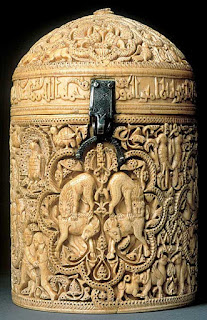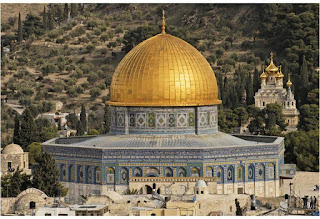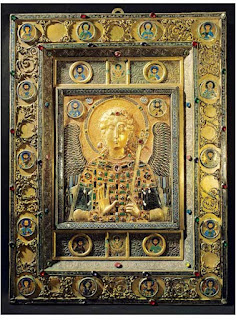What? Bayeux Tapestry
When?
Where?
Why?
Thursday, November 19, 2015
High cross of Muiredach
What? High cross of Muiredach
When? 923
Where? Monasterboice, Ireland
Why? Made of Sandstone and is an early medieval Irish high cross and shows themes suited to a Christian burial.
When? 923
Where? Monasterboice, Ireland
Why? Made of Sandstone and is an early medieval Irish high cross and shows themes suited to a Christian burial.
Psalm 44
What? Psalm 44
When? 820-835
Where? Utrecht Psalter
Why? Painting of Matthew and of the abbey of Saint Peter
When? 820-835
Where? Utrecht Psalter
Why? Painting of Matthew and of the abbey of Saint Peter
Animal-head post
What? Animal-head post
When? 815-820
Where? Oseberg
Why? found in the ships burial chamber and function is unknown
When? 815-820
Where? Oseberg
Why? found in the ships burial chamber and function is unknown
Abbey Church plan
What? Longitudinal section and plan of the abbey church of Saint Michaels
When? 1001-1031
Where? Hildesheim, Germany
Why? Features transformed the tunnel-like horizontally of Early Christian basilicas
When? 1001-1031
Where? Hildesheim, Germany
Why? Features transformed the tunnel-like horizontally of Early Christian basilicas
Uta Codex
What? Abbes Uta dedicating her codex to the Virgin
When? 1025
Where? Regensburg, Germany
Why? Tempera on parchment, illustrates the important role that women played both in religious life and as patrons of arts
When? 1025
Where? Regensburg, Germany
Why? Tempera on parchment, illustrates the important role that women played both in religious life and as patrons of arts
Hildesheim column
What? Column
When? 1015-1022
Where? Hildesheim
Why? Bronze column with reliefs depicting additional episodes from Jesus's life
When? 1015-1022
Where? Hildesheim
Why? Bronze column with reliefs depicting additional episodes from Jesus's life
Palatine Chapel of Charlemagne interior
What? Interior of the Palatine Chapel of Charlemagne
When? 792-805
Where? Aachen, Germany
Why? The first vaulted medieval structure north of the Alps.
When? 792-805
Where? Aachen, Germany
Why? The first vaulted medieval structure north of the Alps.
Cloak of Saint Matthew
What? Man (symbol of Saint Matthew) folio 21 verso of the Book of Durrow
When? 660-680
Where? Iona, Scotland
Why? The cloak of Saint Matthews man resembles a cloisonne brooch filled with abstract ornamentation from medieval book that had 4 pages devoted to the symbols of the four evangelists.
When? 660-680
Where? Iona, Scotland
Why? The cloak of Saint Matthews man resembles a cloisonne brooch filled with abstract ornamentation from medieval book that had 4 pages devoted to the symbols of the four evangelists.
Gero Crucifix
Who? Ottonian sculptor
What? Crucifix commisioned by Archbishop Gero
When? 970
Where? Cologne, Germany
Why? Carved in oak then painted and gilded is a statue and reliquary. Compartment in the back of his head that held bread for the Eucharist.
What? Crucifix commisioned by Archbishop Gero
When? 970
Where? Cologne, Germany
Why? Carved in oak then painted and gilded is a statue and reliquary. Compartment in the back of his head that held bread for the Eucharist.
Equestrian portrait
What? Equestrian portrait of Charlemagne or Charles the Bald
When? 9th century
Where? Metz, France
Why? Carolingian emperors sought to revive the glory and imagery of the Roman Empire. Crowned emperror holding a globe as a symbol of world domination.
When? 9th century
Where? Metz, France
Why? Carolingian emperors sought to revive the glory and imagery of the Roman Empire. Crowned emperror holding a globe as a symbol of world domination.
Detail of mosaics
Who? Byzantine artists
What? Detail of mosaics in the courtyard arcade of the Great Mosque
When? 706-715
Where? Damascus, Syria
Why? Buildings and landscapes common in late antique art but no zoomorphic forms.
What? Detail of mosaics in the courtyard arcade of the Great Mosque
When? 706-715
Where? Damascus, Syria
Why? Buildings and landscapes common in late antique art but no zoomorphic forms.
Pysix of al-Mughira
What? Pyxis of al-Mughira
When? 968
Where? Cordoba, Spain
Why? Royal workshops produced this and several luxurious objects. Made of ivory with hunting motifs and vine scrolls.
When? 968
Where? Cordoba, Spain
Why? Royal workshops produced this and several luxurious objects. Made of ivory with hunting motifs and vine scrolls.
Prayer hall of the Mezquita
What? Prayer hall of the Mezquita
When? 8th to 10th centuries
Where? Cordoba, Spain
Why? shows how they changed their arches some to form them in more of a horseshoe
When? 8th to 10th centuries
Where? Cordoba, Spain
Why? shows how they changed their arches some to form them in more of a horseshoe
Mausoleum of the Samanids
What? Mausoleum of the Samanids
When? Early 10th century
Where? Bukhara, Uzbekistan
Why? A monumental tomb and is one of the oldest.
When? Early 10th century
Where? Bukhara, Uzbekistan
Why? A monumental tomb and is one of the oldest.
Mihrab
What? Mihrab
When? 1354
Where? Isfahan, Iran
Why? Masterpiece of mosaic tilwork because every piece had to be cut to fit its specific place in the design. (perfect aesthetic union of Islamic calligraphy and ornamentation)
When? 1354
Where? Isfahan, Iran
Why? Masterpiece of mosaic tilwork because every piece had to be cut to fit its specific place in the design. (perfect aesthetic union of Islamic calligraphy and ornamentation)
Tughra of Suleyman the Magnificent
Who? Tughra of Suleyman the Magnificent
What? Hish famous signature as an architect
When? 1555-1560
Where? Ottoman architect
Why? His signature because he was great and it was very intricate
What? Hish famous signature as an architect
When? 1555-1560
Where? Ottoman architect
Why? His signature because he was great and it was very intricate
Muqarnas Dome
What? Muqarnas Dome, Hall of the Abencerrajes, Palace of the Lions
When? 1354-1391
Where? Granada, Spain
Why? Octagonal drum that is intricately carved stucco muqarnas creating a starry sky effect.
When? 1354-1391
Where? Granada, Spain
Why? Octagonal drum that is intricately carved stucco muqarnas creating a starry sky effect.
Dome of the Rock
Who? Abd al-Malik
What? Dome of the Rock
When? 687-692
Where? Jerusalem
Why? Mark the triumph of Islam in Jerusalem. Erected by Abd al-Malik
What? Dome of the Rock
When? 687-692
Where? Jerusalem
Why? Mark the triumph of Islam in Jerusalem. Erected by Abd al-Malik
Blue Koran
What? Blue Koran
When? 9th to mid 10th century
Where? Kairouan
Why? Blue dyed page with gold writing
When? 9th to mid 10th century
Where? Kairouan
Why? Blue dyed page with gold writing
Christ as Pantokrator
What? Chist as Pantokrator
When? 1090-1100
Where? Daphni, Greece
Why? This is a dome mosaic in the Church of the Dormition and is like a gigantic icon hovering in space
When? 1090-1100
Where? Daphni, Greece
Why? This is a dome mosaic in the Church of the Dormition and is like a gigantic icon hovering in space
Throne of Maximianus
What? Throne of Maximianus
When? 546-556
Where? Ravenna
Why? Throne made of ivory signifying the bishops importance
When? 546-556
Where? Ravenna
Why? Throne made of ivory signifying the bishops importance
Christ as savior of souls
What? Christ as savior of souls
When? Early 14th century
Where? Saint clement, Ohrid
Why? Notable for the lavish use of finely etched silver foil, its tempera linen and silver on wood (Ohrid icons)
When? Early 14th century
Where? Saint clement, Ohrid
Why? Notable for the lavish use of finely etched silver foil, its tempera linen and silver on wood (Ohrid icons)
Archangel Michael
What? Archangel Michael
When? Early sixth century
Where? British Museum, London
Why? Unusually large Byzantine ivory panel modeled Michael on a classical winged Victory (floating)
When? Early sixth century
Where? British Museum, London
Why? Unusually large Byzantine ivory panel modeled Michael on a classical winged Victory (floating)
Christ before Pilate
What? Christ before Pilate from Rossano Gospels book.
When? Early Sixth century
Why? Important early Byzantine meieval books from texts of four gospels
When? Early Sixth century
Why? Important early Byzantine meieval books from texts of four gospels
Theodora and attendants
What? Theodora and attendants
When? 547
Where? Ravenna, Italy
Why? Mosiac on teh south wall of the apse
How? Similar to Justinian mosaic
When? 547
Where? Ravenna, Italy
Why? Mosiac on teh south wall of the apse
How? Similar to Justinian mosaic
Annunciation
What? Annunciation, reverse of two sided icon from the Church of the Virgin Peribleptos
When? Early 14th Century
Where? Ohrid, Macedonia
Why? Takes place in sacred place because of golden sky
When? Early 14th Century
Where? Ohrid, Macedonia
Why? Takes place in sacred place because of golden sky
Saint Apollinaris amid sheep
What? Saint Apollinaris amid sheep
When? 533-549
Where? Ravenna, Italy
Why? Apse mosaic represents cross that Constantine erected on the hill of Calvary to commemorate the martyrdom of Jesus.
When? 533-549
Where? Ravenna, Italy
Why? Apse mosaic represents cross that Constantine erected on the hill of Calvary to commemorate the martyrdom of Jesus.
Archangel Michael icon
Who? Byzantine and local artists
What? Archangel Michael icon
When? 1100
Where? Venice
Why? Interior church altarpieces (icon)
What? Archangel Michael icon
When? 1100
Where? Venice
Why? Interior church altarpieces (icon)
Virgin and Child
What? Virgin and Child between Saints Theodore and George
When? 6th or early 7th Century
Where? Mount Sinai, Egype
Why? Encaustic on wood, roman tradition of portrait painting on small wood panels called "Icons"
When? 6th or early 7th Century
Where? Mount Sinai, Egype
Why? Encaustic on wood, roman tradition of portrait painting on small wood panels called "Icons"
Hosios Loukas
Who? Islamic Architect
What? Hosios Loukas
When? 11th Century
Where? Distomo, Greece
Why? Katholikon= main church, Second golden age of Byzantine art and architecture.
Hagia Sophia
Who? Anthemius of Tralles and Isidorus of Miletus
What? Hagia Sophia
When? 532-537 AD
Where? Constantiople, Turkey
Why?Golden age of Byzantine are and architecture, most magnificent church
What? Hagia Sophia
When? 532-537 AD
Where? Constantiople, Turkey
Why?Golden age of Byzantine are and architecture, most magnificent church
Tuesday, November 3, 2015
Priest of Serapis
Mummy Portrait of a priest of Serapis
140-160 CE
Hawara, Egypt
Encaustic art on wood using colors mixed with hot wax
Placed on the dead's mummy cases instead of masks

140-160 CE
Hawara, Egypt
Encaustic art on wood using colors mixed with hot wax
Placed on the dead's mummy cases instead of masks
Apollodorus of Damascus
Apollodorus of Damascus
100-112 CE
Rome, Italy
Made of brick faced concrete
Multilevel complex of barrel-vaulted shops and admin offices

100-112 CE
Rome, Italy
Made of brick faced concrete
Multilevel complex of barrel-vaulted shops and admin offices
Al-Khazneh
Al-Khazneh "Treasury"
Second century CE
Petra, Jordan
Rock cut tomb facade
An example of Roman "baroque" architechture

Second century CE
Petra, Jordan
Rock cut tomb facade
An example of Roman "baroque" architechture
Procession of the imperial family
Procession of the imperial family
13-9 BCE
Rome, Italy
Made of marble
Act out an event that recurred every four years
Frigidarium
Frigidarium, Baths of Diocletian
298-306 CE
Rome, Italy
Gives idea of the lavish adornment of imperial Roman baths

298-306 CE
Rome, Italy
Gives idea of the lavish adornment of imperial Roman baths
Portrait bust of Livia
Portrait bust of Livia
Early first century CE
Arsinoe, Egypt
Made of marble and depicted as many goddesses

Early first century CE
Arsinoe, Egypt
Made of marble and depicted as many goddesses
Gardenscape
Gardenscape
30-20 BCE
Primaporta, Italy
Example of a Second Style "picture window"
Used atmospheric perspective intentionally blurring the most distant forms

30-20 BCE
Primaporta, Italy
Example of a Second Style "picture window"
Used atmospheric perspective intentionally blurring the most distant forms
Greek poet Menander
Seated portrait of the Greek poet Menander
62-79 CE
Menander, Pompeii
Fourth Style mural painting in exerda 23 of the house of Menander
The first to write New Comedy

62-79 CE
Menander, Pompeii
Fourth Style mural painting in exerda 23 of the house of Menander
The first to write New Comedy
Arch of Constantine
Arch of Constantine
312-315- CE
Rome, Italy
Commemorate Constantine's defeat of Maxentius
Sculptural decoration from earlier monuments of Trajan, Hadrian and Marcus Aurelius

312-315- CE
Rome, Italy
Commemorate Constantine's defeat of Maxentius
Sculptural decoration from earlier monuments of Trajan, Hadrian and Marcus Aurelius
Temple of Venus
The Temple of Venus
The restored view on the left and the plan view on the right
Third century CE
Baalbek, Lebanon
Baroque temple made of stone violates almost every rule of classical design

The restored view on the left and the plan view on the right
Third century CE
Baalbek, Lebanon
Baroque temple made of stone violates almost every rule of classical design
Subscribe to:
Comments (Atom)
































